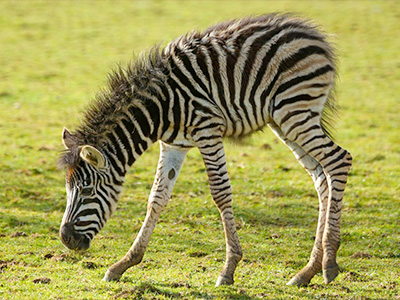Cotswold Wildlife Park delighted with arrival of Zebra foal

Cotswold Wildlife Park welcomes its latest arrival (and first large mammal birth of 2016) – a Chapman’s Zebra foal named Spot. Mare Xena gave birth inside her stable and the tiny colt spent his first few weeks there by his mother’s side and away from public view. The foal’s father (and harem stallion) is called Spongebob. Visitors named the new colt via the Park’s Facebook page.
Spot has now ventured outside and is exploring the paddock, never far from the watchful eye of Xena. The new addition is the sixth member to join the ‘dazzle’ (the collective noun for a group of Zebras). Visitors can see the foal in the Zebra enclosure opposite the Rhino paddock.
Curator of Cotswold Wildlife Park, Jamie Craig, commented: “We are always delighted with any birth at the Park but to arrive at work to the sight of a new born foal gambolling around the zebra paddock was especially satisfying – watching the youngster settling in with the herd and familiarising itself with his surroundings under the watchful eye of his mother is a real treat. We look forward to watching him develop, hopefully with slightly more “African” weather!”
Cotswold Wildlife Park has been home to these iconic African animals since 1976 (early archive photograph pictured right of a fearless Grevy’s Zebra chasing one of the Park’s Rhinos around the paddock). The first Chapman’s Zebra (Equus quagga chapmani) arrived at the Burford collection in 1978, eight years after the Park first opened to the public on Good Friday, 27th March 1970. This latest arrival marks the forty-third Chapman’s Zebra birth - a testament to the Park’s successful breeding programme.
The gestation period for a Zebra is approximately twelve months. Females give birth to a single foal. Soon after birth, they are able to stand up and walk. During the first few weeks of life, the mother is very protective. The foal recognises his mother by her call, her scent and her stripe pattern*. The mare’s protectiveness ensures that the foal will not imprint on another animal. The mare will suckle her foal throughout and beyond his first year and their bond is an incredibly strong one.
Zebras are the only wild horses that remain plentiful in their natural range in the African plains. They are related to the now extinct Quagga (a cross between a Zebra and a horse) of which millions were killed, many simply for sport. Some were transported to zoos where breeding was thought unnecessary, as it was believed numbers were plentiful in the wild. Sadly, the last Quagga died in Amsterdam Zoo on 12th August 1883.
In 2012, researchers at Sweden’s Lunds University examined potential evolutionary reasons for the Zebra’s distinctive striped markings. They began by studying horses that had black, brown or white coats. They discovered that white-coated horses were much less troubled by horseflies than their dark-coloured relatives. By setting up insect glue-covered boards with different patterns, researchers found that a white-and-black striped pattern, replicating the coat of a Zebra, attracted the least amount of flies by a large margin. Their research revealed that stripes probably evolved to repel bloodsuckers, successfully scrambling their vision.
Explore Gloucestershire
4 April 2016
For further information.
OTHER NEWS
